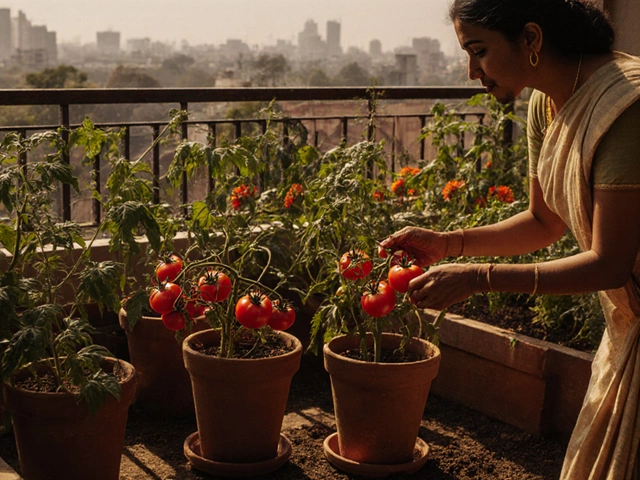India’s national flower isn’t just a symbol you learn about in school—it’s something you can actually see around ponds, lakes, and even in home gardens if you know where to look. The lotus, with its pale pink or sometimes bright white petals, is way more than a background plant in old paintings. It thrives in simple, muddy water, which just adds to its charm and reputation for bouncing back no matter what.
If you’re thinking about planting something that stands out and has a real story, the lotus should be at the top of your list. It can handle India’s blazing summers and crazy monsoon rains, popping up fresh every year as the water levels rise. And if you’ve ever bought a bunch of flowers from a roadside stall, you’ll notice lotuses sell out fast—locals know these blooms aren’t just good-looking, they bring luck and have all sorts of uses you’d never guess.
- Spotlight on the Lotus: India’s Chosen Flower
- Stories and Meanings Tied to the Lotus
- Where and When to Find Lotus Across India
- Growing Lotus at Home: Easy Steps
- Surprising Uses of Lotus in Daily Life
- Quick Tips to Enjoy and Protect the Lotus
Spotlight on the Lotus: India’s Chosen Flower
If you look through any Indian textbook or even a government emblem, you’ll spot the lotus. It’s not picked just for its looks—the government declared the lotus as the India national flower back in 1950, and it’s stuck around for a good reason. The official name is Nelumbo nucifera, but most people just call it the Indian lotus or water lily. You’ll see it growing wild all over India, especially in ponds, river backwaters, and temple tanks.
This flower isn’t just famous here; it’s actually found across Asia, and even gets called the ‘sacred lotus’ thanks to all the stories and religious roles attached to it. One cool thing: lotuses can regulate the temperature of their flowers even when the water around them is chilly. That means bees and insects can still land and do their thing, even on early cold mornings.
Take a look at some key facts and figures about the lotus across India:
| Fact | Detail |
|---|---|
| Botanical Name | Nelumbo nucifera |
| Declared National Flower | 1950 |
| Peak Blooming Season | June to September |
| Typical Height | Up to 1.5 meters (5 feet) |
| Lifespan (per bloom) | About 3 days |
| States with Major Lotus Growth | West Bengal, Tamil Nadu, Uttar Pradesh, Assam |
Lotus flowers are easy to spot because of their big round leaves that almost look like green plates floating on water. Each flower opens in the morning and closes by afternoon, almost like it’s on a schedule. And while the flowers are definitely the main attraction, the huge leaves and unique seeds are just as useful—locals use them for food, medicine, and even art projects.
If you’re wandering near a lake or temple pond, especially during the rainy months, you’ll probably run into these flowers in full bloom. This isn’t just about beauty—the lotus stands for strength, purity, and new beginnings in Indian culture. That’s a lot of meaning packed into one blossom you can still find growing wild, without any fuss.
Stories and Meanings Tied to the Lotus
The lotus is everywhere in Indian stories, art, and temples. It’s not just about looking good—this flower means something deep for a lot of people. The big deal with the lotus is how it pushes through muddy water and still ends up clean and pretty. That’s why people use it as a sign of rising above problems or living a good life no matter what’s around you. In old Indian texts and stories, it stands for purity, rebirth, and new beginnings.
Almost every religion in India mentions the lotus. Hindu gods like Lakshmi and Vishnu are pretty much always shown with lotuses—either holding them or sitting on them. In Buddhism, it’s one of the main symbols for enlightenment. You’ll spot it carved into old stones and on the front of temples. Even in the Indian Constitution, the lotus pops up as a symbol of the nation.
"Just as a lotus flower is born in water, grows in water and rises out of water to stand above it unsoiled, so, too, a man can rise above worldly temptations and become free." — S. Radhakrishnan, former President of India
If you want to know how deeply the India national flower matters, check this out:
| Place | Lotus Reference | Meaning |
|---|---|---|
| Currency | Lotus printed on ₹1 coins | National identity |
| Temples | Lotus carvings and shapes | Spiritual purity |
| Festivals | Used in decor and rituals | Good luck, fresh start |
The lotus isn’t stuck in the past, either. Kids draw it on school projects, politicians use it during campaigns, and people buy it for housewarming gifts. This flower feels like it’s everywhere once you start looking—so next time you see one, you’ll know it means a lot more than just a pretty face.
Where and When to Find Lotus Across India
It’s easy to spot the lotus in so many corners of India—you just need to know where and when to look. The best time is the rainy season, mostly from June to September. That’s when lakes and ponds fill up, and suddenly, you can see those pale pink or white petals bobbing on the water. Some places hold onto lotus blooms right through October, thanks to longer monsoons or local climate quirks.
If you want a sure shot, plan a trip to Jammu and Kashmir’s Dal Lake, where the lotus practically takes over the water in late summer. Back down south, watch out for the huge lotus beds in Tamil Nadu’s marshy fields near Sivaganga or Chengalpattu—especially after strong rains. Even in the middle of cities, pond parks like Rabindra Sarovar in Kolkata and the marshes around Hyderabad’s Hussain Sagar come alive with lotus patches.
For anyone staying around Uttar Pradesh or Bihar, check out village ponds once the rains begin. Farmers often grow lotus alongside regular crops because both the seeds and roots sell well at local markets. Plus, several famous temple tanks in places like Udupi and Madurai are dotted with these blooms—people often offer fresh lotuses during religious rituals, so they’re kept well-tended all year.
Here’s a quick list of top spots for lotus watching season:
- Dal Lake, Srinagar (Jammu & Kashmir)
- Keoladeo National Park, Bharatpur (Rajasthan)
- Kukrail Reserve, Lucknow (Uttar Pradesh)
- Rabindra Sarovar, Kolkata (West Bengal)
- Wetlands around Chengalpattu and Sivaganga (Tamil Nadu)
So if you’ve ever wondered how locals manage to use fresh lotus for festivals and food, now you know—they grow like crazy in the monsoon, and you don’t have to look far. When it comes to India national flower, seeing a blooming pond up close is worth it. Grab your phone, find the nearest spot, and you’ll get why this flower is such a big deal here.

Growing Lotus at Home: Easy Steps
So you want a piece of India’s most iconic flower at home? Lotuses aren’t as tricky as folks think, but you do need to follow some specific steps if you want those big, beautiful blooms popping up from your pond or tub every year.
First off, you don’t need a huge garden. Lotuses can grow in buckets, tubs, or any wide, shallow container that holds water. Just make sure your container is at least 30-40 cm deep so the roots have space. Here’s a simple breakdown to keep it stress-free:
- Choose the Right Variety: There are small varieties meant for containers, like the Dwarf Momo Botan. Big-flowered types work well in ponds but need more space.
- Pick a Good Container: Go for a plastic or ceramic tub without drainage holes (so water stays in). A diameter of at least 40 cm works best.
- Prep the Soil: Use heavy garden soil or clay, not potting mix. Avoid soil with added fertilizer at first—lotus roots don’t like strong chemicals.
- Plant the Rhizome: Gently push the lotus rhizome sideways into the mud, with the growing tips slightly above the soil. Don’t break the tips—they’re fragile.
- Top Up with Water: Add water slowly to cover the soil by about 10 cm. As leaves start to show, you can raise water height up to 20-25 cm.
- Pick a Warm, Sunny Spot: Lotuses love at least 6 hours of sun each day. Warmth wakes up those roots and gets them growing faster.
- Feed and Maintain: Once the plant puts out a few leaves, you can use a slow-release aquatic fertilizer. Just don’t overdo it! Remove yellow leaves and clean old stems to keep things tidy.
Here’s some quick data to help your setup go smoothly:
| Step | Key Data |
|---|---|
| Water Depth for Growth | 10–25 cm above soil |
| Minimum Sunlight | 6 hours per day |
| Ideal Water Temperature | 22–30°C |
| Bloom Season | April to September |
Quick tip: Never let the pot dry out. If you use tap water, leave it standing overnight before adding, so chemicals can settle. With just a bit of care, even beginners can enjoy the magic of India national flower blooming in their own backyard. Don’t stress if it takes a season for big flowers—lotuses like to take their time.
Surprising Uses of Lotus in Daily Life
Lotus isn’t just for ponds or pretty pictures—people across India put every part of the plant to work. The flower, root, seeds, and even leaves end up in kitchens, temples, and everyday routines. If you imagine it only sitting in water, you’ll be surprised at how often it pops up around you.
Food-wise, lotus root—or "kamal kakdi"—shows up in all sorts of dishes. In states like Punjab or UP, families slice and fry it for crunchy snacks, toss it in curries, or pickle it for a tangy bite. The seeds “makhana” get roasted as a healthy snack or even used in halwa (a sweet dish). Next time you spot a pack at the market, remember they’re packed with protein and magnesium, making them more than just filler food.
Health tricks come next. Traditional medicine uses lotus petals and roots for cooling the body or calming a queasy stomach. Some home remedies even use lotus juice to soothe sunburns. Crazy, right? It’s not all old wives’ tales—modern research now shows extracts from the India national flower can act as antioxidants.
- Religious uses: Lotus flowers are offered in Hindu temples and during pujas. Because the plant grows clean in muck, it stands for purity. That’s why images of gods like Lakshmi or Saraswati almost always show them sitting on lotuses.
- Decoration: Fresh or dried lotus make simple (and long-lasting) home displays. You’ll see them in weddings or festivals for extra color or a traditional vibe.
- Eco uses: Lotus leaves work as natural plates at festivals or community meals. One quick wash, and they’re ready for rice, curry, or snacks—no plastic waste needed.
The table below gives a quick look at how the lotus plant pops up in daily life in different ways:
| Lotus Part | Common Use | Region/Context |
|---|---|---|
| Root (Kamal Kakdi) | Curries, fries, pickles | North India, especially Punjab, UP |
| Seeds (Makhana) | Roasted snack, kheer, halwa | Bihar, as healthy food pan-India |
| Flowers | Puja offerings, décor | All over India |
| Leaves | Natural plates, folk medicine | Rural festivals, Ayurveda |
So, whenever you notice a lotus at a roadside stall or by a temple pond, remember it’s likely heading straight to someone’s kitchen, prayer room, or even their dinner table as a simple plate. Simple, useful, and way more important than it first looks.
Quick Tips to Enjoy and Protect the Lotus
If you want to get the best out of the lotus, it helps to know what really works. These practical tips can make a big difference, whether you’re just admiring wild lotus blooms or trying to keep them alive in your own pond or tub.
- India national flower blooms in still, clean water—so if you're growing them, change the water every week or so if you have a container or small pond.
- Avoid using chemical fertilizers. Too much can harm both the plant and local fish. Instead, use organic pond compost or natural manure in moderate amounts.
- Place lotus containers where they get at least 5–6 hours of direct sunlight daily. Shady spots will stunt growth and cut down on blooms fast.
- If you spot bugs like aphids or caterpillars, spray the leaves with a strong jet of water or use neem oil. Don’t use off-the-shelf pesticides—they aren’t safe for water plants or nearby animals.
- Respect local laws—a lot of lakes in India protect lotuses. Never pluck lotuses from public lakes or reserves. It’s not just bad manners; it’s also illegal in many places.
- If you want to take photos, do it early morning when the blooms are fresh and light is good. The flowers close up in the heat by afternoon.
If you’re interested in how lotus blooms survive, check this out:
| Fun Fact | Details |
|---|---|
| Lotus tolerance | Can survive up to 35°C heat during Indian summers |
| Flowering season | Peaks June–September, with the monsoon |
| Seed longevity | Viable seeds found after 1,300 years (oldest on record) |
“Growing and preserving lotuses is all about patience—leave them alone and just keep the water clean. You can’t force a lotus to bloom, but it’ll reward you if you give it space.” — Dr. Rajeev Bhandari, botanist at Lucknow University
If you spot local lotus beds, don’t enter the water to get closer—it’s bad for the plants and your safety. Stick to paths or viewing spots and encourage others to do the same. Sharing photos or talking about lotus care helps raise awareness, so don’t hold back if you have handy tips for your friends or family. Treat the lotus right and it’ll stick around for the next generation to discover.





